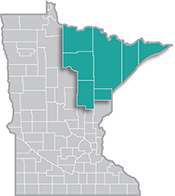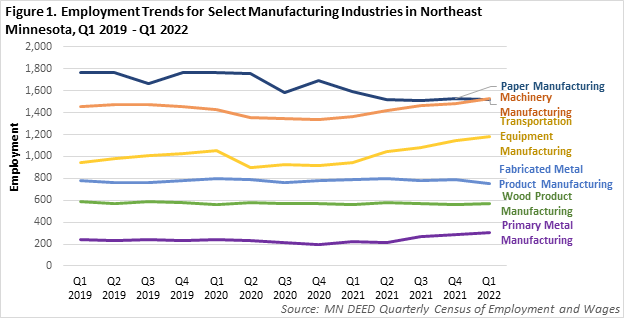 Home to the state's second-largest metro, the Northeast Region has a strong industrial sector, tied largely to the area's abundant natural resources.
Home to the state's second-largest metro, the Northeast Region has a strong industrial sector, tied largely to the area's abundant natural resources.
Most of the manufacturing base centers on mining and forest products industries. More than half of the sector's employment is in paper and machinery manufacturing.
Want the freshest data delivered by email? Subscribe to our regional newsletters.
9/22/2022 9:00:00 AM
Carson Gorecki
The Manufacturing sector in Northeast Minnesota is home to over 8,400 jobs at 342 business establishments, operating in 17 different subsectors ranging from producing paper, wood, food, metal products, apparel, furniture, transportation equipment, and much more! In the first quarter of 2022, Manufacturing provided 6.5% of total jobs in the region, making it the 6th largest-employing sector in the area, but also over $556 million in wages, accounting for 8.0% of total payroll. In comparison, Manufacturing is the second- largest sector statewide, providing just over 11% of total employment.
Since the beginning of the COVID-19 pandemic, the Manufacturing sector has fared better than many other sectors, all the while producing goods at a time of distinct need. While employment fell by over 730 jobs from second quarter 2019 to second quarter 2020, the -8.2% employment decline was much lower than the average percent decline across all industries (-15.2%).
Since that low point of employment in second quarter 2020, the Manufacturing sector has added over 250 new jobs in the region, to a tune of 3.1% growth into the first quarter of 2022. Over that period, employment growth trailed some other industries, but mainly because there were relatively fewer Manufacturing jobs to recover when compared to sectors such as Accommodation & Food Services and Arts, Entertainment & Recreation, which both saw much larger employment deficits relative to the pre-pandemic period.
Manufacturing has performed better than most sectors, with diverse industries within the sector experiencing varied outcomes over the past two to three years. The three largest Manufacturing industries in the region – Machinery, Paper, and Transportation Equipment – account for half of the sector's employment.

Paper Manufacturing, which had seen many years of employment losses leading into the pandemic (a loss of 880 jobs since 2011), saw that trend continue over the last two years. At the same time, Transportation Equipment Manufacturing, a growing specialty of the region, saw continued growth with an addition of 242 jobs over the year into the first quarter of 2022. Machinery Manufacturing, while suffering losses in 2020, returned to employment growth in 2021 and 2022. As of the first quarter of 2022, Machinery Manufacturing became the largest employing Manufacturing subsector in the region, taking the mantle from the declining Paper Manufacturing industry. From first quarter 2020 to first quarter 2022, the two fastest growing industries were Primary Metal Manufacturing (+28.6%), and Transportation Equipment Manufacturing (+12.4%) (see Figure 1).
The Manufacturing sector pays an average annual wage of just over $69,000 which is more than $16,000 higher than the total across all industries in the region as of the first quarter of 2022. Within the sector, wages range from lows just above $30,000 in Apparel, Textile Product Mills, and Beverage & Tobacco Product Mfg. to highs above $80,000 per year in Paper, Transportation Equipment, and Primary Metal Manufacturing (see Table 1).
From first quarter 2020 to first quarter 2022, Manufacturing wages grew an average of 6.5%, which was well below the 11.9% wage gain experienced in the total of all industries. However, if you move the base period up one quarter to the second quarter of 2020, Manufacturing wages grew 12.3% while the all-industry average ticked up just 6.9%. When annual averages are used to minimize seasonal effects, Manufacturing wages grew 7.8% from 2019 to 2021, while all sectors saw an increase of 12%, due to large gains in lower-wage sectors such as Leisure & Hospitality.
The good news is that all Manufacturing industries saw wages rise over the past two years, with the largest wage increases occurring in Chemical Manufacturing (+26.2%), Computer and Electronic Product Manufacturing (+24.4%), and Beverage and Tobacco Product Manufacturing (+20.4%).
| Table 1. Northeast Minnesota Manufacturing Sector Employment and Wage Statistics, 2020-2022 | |||||||
|---|---|---|---|---|---|---|---|
| Industry Title | Q1 2022 Employment | Q1 2020 - Q1 2022 | Q1 2021 - Q1 2022 | Average Annual Wage (Q1 2022) | Percent Wage Change (Q1 2020 - Q1 2022) | ||
| Numeric Change | Percent Change | Numeric Change | Percent Change | ||||
| Total, All Industries | 130,054 | -9,865 | -7.1% | 3291 | +2.6% | $52,624 | +6.5% |
| Manufacturing | 8,433 | -316 | -3.6% | 330 | +4.1% | $69,056 | +13.6% |
| Machinery Mfg. | 1,525 | +99 | +6.9% | 157 | +11.5% | $66,716 | +9.6% |
| Paper Mfg. | 1,522 | -240 | -13.6% | -73 | -4.6% | $92,664 | +1.1% |
| Transportation Equipment Mfg. | 1,186 | +131 | +12.4% | 242 | +25.6% | $83,616 | +15.8% |
| Fabricated Metal Product Mfg. | 751 | -49 | -6.1% | -40 | -5.1% | $61,620 | +13.3% |
| Wood Product Mfg. | 569 | +9 | +1.6% | 11 | +2.0% | $66,872 | +7.3% |
| Nonmetallic Mineral Product Mfg. | 435 | -17 | -3.8% | -5 | -1.1% | $75,504 | +21.7% |
| Primary Metal Mfg. | 306 | +68 | +28.6% | 82 | +36.6% | $79,404 | -14.8% |
| Beverage and Tobacco Product Mfg. | 293 | +15 | +5.4% | 29 | +11.0% | $33,696 | +5.8% |
| Plastics and Rubber Products Mfg. | 291 | -96 | -24.8% | -52 | -15.2% | $43,992 | +4.8% |
| Computer and Electronic Prod. Mfg. | 262 | -104 | -28.4% | -27 | -9.3% | $65,936 | +9.7% |
| Food Mfg. | 243 | -53 | -17.9% | -15 | -5.8% | $54,860 | +10.6% |
| Textile Product Mills | 223 | +19 | +9.3% | 41 | +22.5% | $33,488 | +1.6% |
| Chemical Mfg. | 195 | -15 | -7.1% | 5 | +2.6% | $71,968 | -3.4% |
| Printing & Related Support Act. | 180 | -21 | -10.4% | -3 | -1.6% | $37,596 | +6.4% |
| Miscellaneous Mfg. | 137 | -55 | -28.6% | -32 | -18.9% | $40,820 | +16.9% |
| Apparel Mfg. | 123 | -19 | -13.4% | 1 | +0.8% | $29,380 | +31.9% |
| Furniture and Related Product Mfg. | 102 | +9 | +9.7% | 5 | +5.2% | $49,972 | +11.9% |
| Source: MN DEED Quarterly Census of Employment and Wages | |||||||
The Manufacturing sector plays a critical role in the Northeast Minnesota economy. Not only does it produce the goods that consumers and businesses demand, but it also offers above average wages, in many cases, for jobs that do not require advanced education or training. Over two-thirds of Manufacturing jobs held in Northeast Minnesota required at most a high school degree while less than 1% required a graduate degree.
Above-average wages and lower educational requirements also mean that Manufacturing is relatively well positioned within the current tight labor market and able to draw from a larger segment of the workforce. However, unless conditions change, tight labor market conditions may continue to limit the growth of this important sector in Northeast Minnesota.
Contact Northeast Minnesota Labor Market Analyst Carson Gorecki at 218-302-8413.